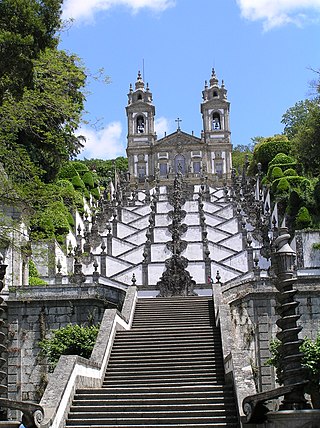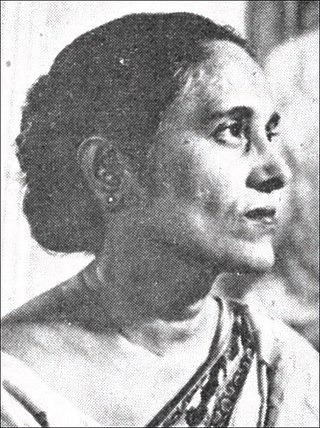Old Goa is a historical site and city situated on the southern banks of the River Mandovi, within the Tiswadi taluka (Ilhas) of North Goa district, in the Indian state of Goa.

Panaji is the capital of the Indian state of Goa and the headquarters of North Goa district. Previously, it was the territorial capital of the former Portuguese India. It lies on the banks of the Mandovi river estuary in the Tiswadi sub-district (taluka). With a population of 114,759 in the metropolitan area, Panaji is Goa's largest urban agglomeration, ahead of Margao and Mormugao.

Officially, the Basilica of Our Lady of the Mount, colloquially known as Mount Bandra and Mount St Mary Church; is a basilica (shrine) of the Roman Catholic Church, located at the Bandra neighbourhood of Bombay (Mumbai), India.

The Sanctuary of Bom Jesus do Monte is a Portuguese Catholic shrine in Tenões, outside the city of Braga, in northern Portugal. Its name means Good Jesus of the Mount.

Ponda, is a city and a municipal council in the North Goa district of Goa, India.

Chorão, also known as Choddnnem or Chodan, is an island along the Mandovi River near Tiswadi, Goa, India. It is the largest among other 17 islands of Goa. It is located 5 kilometres away from the state capital, the city of Panaji and 10 kilometres away from the city of Mapusa.

Diu Island is an island off the southern coast of Gujarat's Kathiawar peninsula, separated from the mainland by a tidal creek. It has an area of 38 km2, and a population of 44,110.

Fontainhas is an old Latin Quarter in Panjim, capital city of the state of Goa, India. It maintains its Portuguese influence, particularly through its architecture, which includes narrow and picturesque winding streets like those found in many European cities, old villas and buildings with projecting balconies painted in the traditional tones of pale yellow, green, or blue, and roofs made of red coloured tiles. Fontainhas' heritage ambience represents the traditional Portuguese influence in the area.
Taleigão, or Platô de Taleigão, is a neighborhood located in the southern part of the city of Panaji, the capital of the Indian state of Goa. It is entirely located on the island of Tiswadi, which is one of the talukas in the state of Goa. The neighborhood is known for its important campus at the Goa University.

Anjediva Island is an Indian island in the Arabian Sea. It sits off the coast of Canacona, Goa. It is politically part of Goa state, geographically the nearest mainland is the Kanara subregion of Karnataka.

The Our Lady of the Immaculate Conception Church is located in Panjim, Goa, India. The Church conducts Mass every day in English, Konkani, and Portuguese.

Monti Fest is a Catholic Christian festival held on the 8th of September every year, by the Latin Christian community of Konkani people, originating in the Konkan region of India & the Konkani Christian migrants in the Canara sub-region of Karnataka, India. This festival celebrates the Nativity of the Blessed Virgin Mary, for the Mangalorean Catholics the festival involves the blessing of Novem. In certain Goan Catholic dialects the festival's name is corrupted to "Moti Fest".

The statue of Our Lady of Miracles, Jaffna Patão, is a wooden sculpture now preserved in the Church of São Pedro in Bainguinim, Goa, India.

Churches and Convents of Goa is the name given by UNESCO to a set of religious monuments located in Goa Velha, in the state of Goa, India, which were declared a World Heritage Site in 1986.
The Fort of São Tiago of Banastarim in India, also known as Fort St. James Banastarim or Benastari Castle, is located at on the right bank of Cumbarjua Canal, on the eastern tip of Old Goa, North Goa district in the state of Goa on the west coast of India.

The Portuguese presence in Asia was responsible for what would be the first of many contacts between European countries and the East, starting on May 20, 1498 with the trip led by Vasco da Gama to Calicut, India. Aside from being part of the European colonisation of Southeast Asia in the 16th century, Portugal's goal in the Indian Ocean was to ensure their monopoly in the spice trade, establishing several fortresses and commercial trading posts.

Church of St. Augustine is a ruined church complex located in Old Goa. The church was completed in 1602 and is part of the World Heritage Site, Churches and convents of Goa.

The Church of Our Lady of the Rosary is a Catholic church built between 1544 and 1547, in Old Goa, State of Goa, India. This church is part of the collection belonging to the World Heritage Site of churches and convents of Goa.

António Xavier Trindade was a prominent Goan painter of the Bombay School in the early 20th century.

Angela Trindade was an Indian painter famous for her Western-style portraits and Christian paintings in the Indian style. As a versatile artist, she also developed her own style called "Trindadism", in which she incorporated the symbolic dimensions of the triangle and the trinity. This unique approach to art allowed Trindade to establish her individuality as an artist.




















